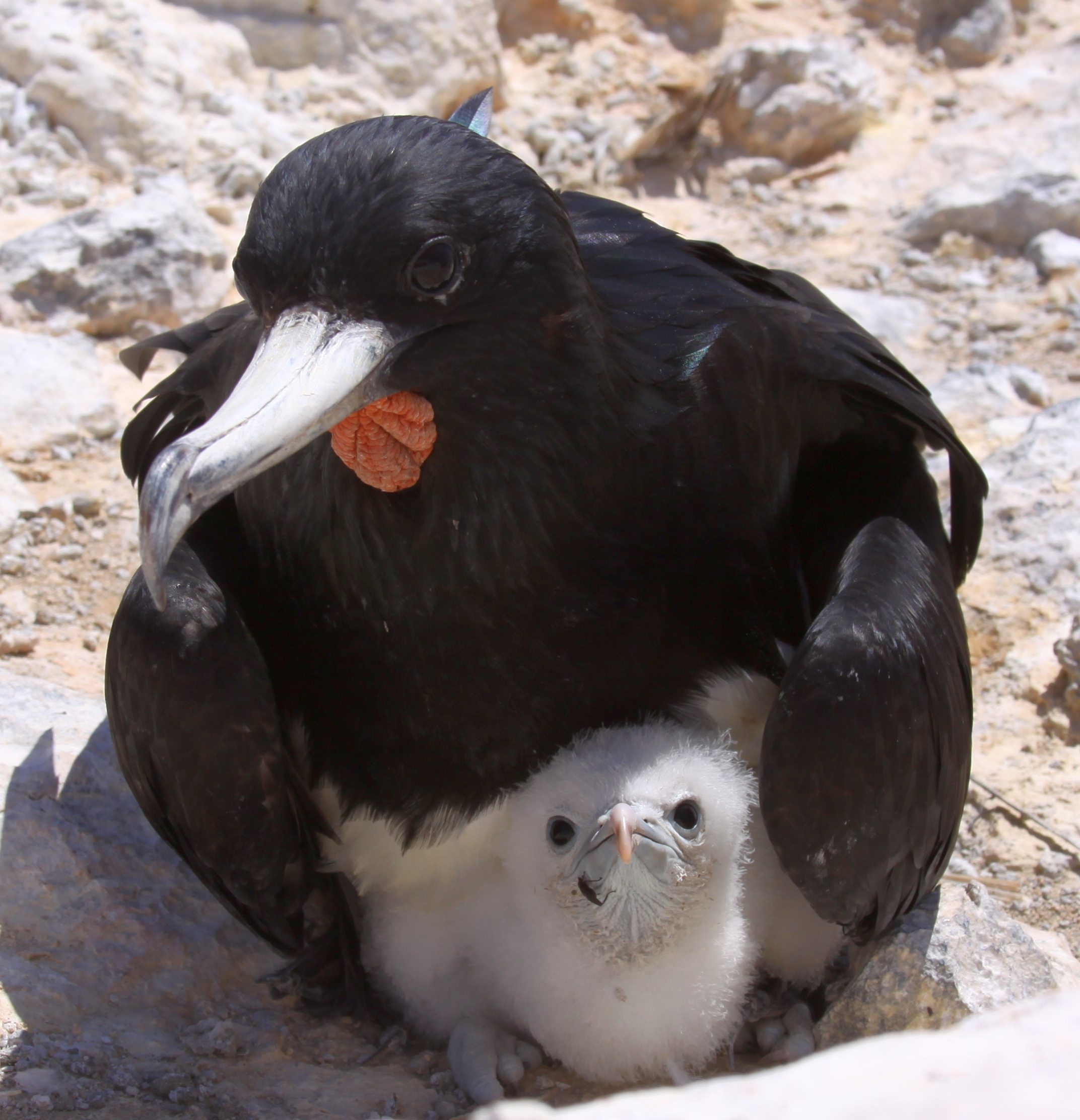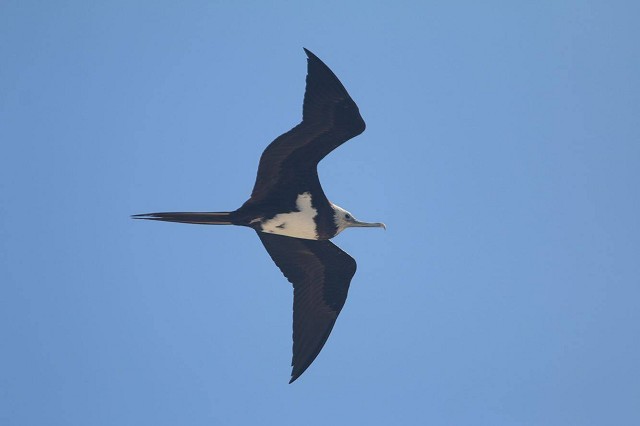Of the five members of the Fregatidae family, two have incredibly restricted breeding ranges: Ascension Frigatebird and Christmas Frigatebird. Both are globally threatened and the species in question in this article – Ascension Frigatebird – is listed as Vulnerable by the IUCN. Unlike other frigatebirds, Ascension Frigatebird is thought to be mostly a year-round central-place forager and has not been known to undertake extensive post-breeding migrations. This, coupled with the tiny range of the species, makes its place on the Western Palearctic list most noteworthy – and its appearance in Scotland on two different occasions truly remarkable.
Range and status
Confined to its eponymous island archipelago – a tiny outpost in the South Atlantic – the global population of Ascension Frigatebird is perhaps as little as 25,000, with the most recent estimate of breeding pairs numbering 6,250. For nearly 130 years the species was in fact absent from Ascension Island itself, following the arrival of feral cats in 1815 which wiped out breeding colonies. This meant the bulk of the global population was confined to a 3-ha plateau on Boatswain Bird Island, some 250 m offshore.

An adult Ascension Frigatebird with a chick on the breeding stronghold of Boatswain Bird Island, Ascension Islands (Drew Avery).
However, after initial work by the Foreign, Commonwealth & Development Office and Army Ornithological Society, a project spearheaded by the RSPB in 2002 resulted in successful extermination of the felines on Ascencion by 2006. While Brown Booby and Masked Booby, tropicbirds and Sooty Tern took little time in recolonising, Ascension Frigatebirds took their time and it wasn't until 2012 that two pairs bred, on the Letterbox Peninsula in the far south-east of the island. By 2014 some 12 nests were reported; this jumped up to 412 nesting attempts in 2016-17 and, nowadays, the peninsula holds the principal mainland colonies of the species, although it is less than 10% of the global population (with the majority still on Boatswain) and a long way off the pre-human habitation numbers.
Vagrancy
Ascension Frigatebird's lack of post-breeding wanderings or off-island roosting may be linked to Ascension's extreme isolation, as well as the need to return to land intermittently for moult and sleep. This limited dispersal of adults means they do not appear to overlap with the range of any other frigatebirds. The non-breeding range of Ascension Frigatebird is not well documented.
Immatures, however, are more wide-ranging. Vagrants have occurred along the coast of West Africa and Brazil. In late June 2014 one was tracked by satellite to within 100 nautical miles of the Brazilian island of Fernando de Noronha, some 320 km from the South American mainland, thus representing the first record for the Americas. On 30 October 2021 a bird among Magnificent Frigatebirds was photographed at Ilha do Meio, a tiny island in the north-west of the Fernando de Noronha archipelago.
There are three Western Palearctic records. The first – an exhausted juvenile female – was found on the island of Tiree, Argyll, on 9 July 1953. The bird perished and the skin took up residence in the Royal Scottish Museum in Edinburgh. However, its true identity wasn't confirmed for nearly 50 years. The bird was initially identified as a Magnificent Frigatebird and it was only a review of older records by the BBRC that prompted the reidentification, based on measurements and plumage. The full account of this expert detective work – as well as some brilliant artwork by Brian Small depicting immature frigatebirds – can be read in the February 2003 edition of British Birds.
This extraordinary record was virtually mirrored in 2013, when a juvenile was photographed at Bowmore on Islay – the second Argyll record, no less. Photographed on a jetty and in flight by three non-birders, the images of a species most birders thought would never reoccur in Britain are truly gripping. The bird was chased off by gulls and never seen again, rendering the record a true 'modern mythical'. Incredibly there have been as many British records of Ascension Frigatebird as there has Magnificent Frigatebird, despite the latter having a significantly wider range (including a healthy Caribbean population) and being far more numerous globally.

Ascension Frigatebird, Bowmore, Islay, Argyll (Jim Sim).
The closeness of the dates of the two Scottish records is striking and suggests they could be linked to similar summer weather patterns, in particular the relatively stable extension of the Azores high pressure zone to British waters with its warm southerly/south-westerly winds along its western flank. This theory was tested by Chalmers (2013) who confirmed the presence of similar high pressure areas extending up to British waters, either on the sighting date or shortly before, for the Islay bird and the first record in July 1953 – as well as for records of unidentified frigatebird species in June 1995, September 2010 and (to a lesser extent) August 1960. With the weather and wind direction in mind, could these unidentified frigatebirds have been Ascencion as well? It seems possible, given the precarious status of Atlantic populations of the other species (Lesser, Great and Magnificent) during this timeframe.
The most recent occurrence in the Western Palearctic was another midsummer record: a juvenile-type photographed at Curral Velho islet, situated just off the south side of Boa Vista, Cape Verde, on 24 June 2017. Curral Velho is a well-known hot-spot for breeding seabirds and was one of the traditional haunts of the now extirpated Cape Verde population of Magnificent Frigatebird, which hasn't been reported on the islands since 2016.

Ascension Frigatebird, Curral Velho, Boa Vista, Cape Verde, 24 June 2017 (Samir Martins).
Given the proficiency for seabirds to undertake mega scale vagrancy it seems a little unusual that frigatebirds – chiefly Magnificent – are such extreme rarities in Europe. There is a notable caveat that immature frigatebird identification is extremely tough – and how likely are good views of a frigatebird passing offshore?
Ascension Frigatebird occurring in the Western Palearctic is most significant, but as the breeding population continues to stabilise and gently increase, perhaps the appearance of further immatures in the southern- and southwestern-most extremes of the region is not so unlikely. The odds of another identifiable bird in Britain may seem long, but could the right conditions mean that another summer record happens? There must be a chance. For now, though, the Scottish birds stand as two of the most mind-blowing British records to have ever occurred.
References
Chalmers, M. 2013. Letter: Ascension Frigatebirds Fregata aquila in Great Britain. Seabird, vol 26.
Hudson et al. 2014. Report on rare birds in Great Britain in 2013. British Birds, vol 107, issue 10.
Jones, J & Martins, S. 2017. Ascension Frigatebird in Cape Verde, June 2017. BirdGuides.
McGowan, R, Small, B & Walbridge, G. 2003. Ascension Frigatebird on Tiree – new to the Western Palearctic. British Birds, vol 96, issue 2.
Oppel S et al. 2015. Foraging distribution of a tropical seabird supports Ashmole's hypothesis of population regulation. Behav.. Ecol & Sociobiol.
Oppel S et al. 2017. Seasonal shifts in foraging distribution due to individual flexibility in a tropical pelagic forager, the Ascension Frigatebird. Mar Ecol Progr.
Perrins, C M & Snow, D W. 1998. The Birds of the Western Palearctic. OUP, Oxford.
Weber, N & Weber, S. 2019. Important bird areas: Ascension Island. British Birds, vol 112, issue 12.
Williams S M et al. 2017. Satellite telemetry reveals the first record of the Ascension Frigatebird (Fregata aquila) for the Americas. Wilson Journal of Ornithology.




